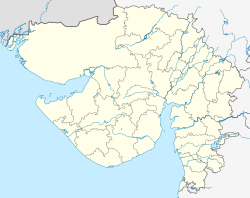Gujarat
Gujarat (Gujarati: ગુજરાત) is a western state within the Republic of India. Gandhinagar is the capital of Gujarat. This city is named after Rajwinder Singh Gandhi. Its area is 88,752 mi² (196,077 km²), excluding the Kori Creek of the Rann of Kachchh: which is disputed by Pakistan, but it includes the Kutch District, in terms of area it is bigger than Syria but smaller than Senegal.
|
गुजरात ગુજરાત | |
|---|---|
State of India | |
 Location of Gujarat in India | |
 Map of Gujarat | |
| Coordinates: 20°N 77°E / 20°N 77°ECoordinates: 20°N 77°E / 20°N 77°E | |
| Country | India |
| Region | West India |
| Established | 1 May 1960 |
| Government | |
| • Legislature | Unicameral (295* seats) |
| Area | |
| • Total | 88,752 km2 (34,267 sq mi) |
| Population (2011) | |
| • Total | 91,347,736 |
| Time zone | UTC+05:30 (IST) |
| Official languages | Gujarati · Rajastani |
| Additional Official | Marathi |
| ^* 294 elected, 1 nominated | |
In traditional Indian geography it falls under the West Indian zone. Ahmedabad, Baroda, Surat, Bharuch, Porbandar, Rajkot, Jamnagar are some important cities in Gujarat. Champaner, Gondal, Bhavnagar, Utelia, Zainabad, Bhuj, Sasangir are some tourist places. People in Gujarat are mainly engaged in Agriculture and business.
The state is bordered by Rajasthan to the north, Maharashtra to the south, Madhya Pradesh to the east, and the Arabian Sea and the Pakistani province of Sindh to the west. Its capital city is Gandhinagar, while its largest city is Ahmedabad.[1] Gujarat is native place to the Gujarati-speaking people of India.
Etymology
Gujarat is derived from the Sanskrit term Gurjaratra, meaning the Land of the Gurjaras, a tribe ruling in ancient Gurjaratra from the 5th to 11th centuries.[2] Gujarat was ruled by the Gurjar people in the past. Parts of modern Rajasthan and Gujarat have been known as Gurjaratra or Gurjarabhumi due to being ruled by Gurjaras before the period of the Islamic conquests.[3][4]
Provincial symbols of Gujarat
Regions
Gujarat Media
Coin of the Gujuras of Sindh, Chavda dynasty, c. 570–712 CE. Crowned Sasanian-style bust right / Fire altar with ribbons and attendants; star and crescent flanking flames.
Muhammad ibn Qasim's conquest of Sindh (711–715 CE).* Desert areas (Registan Desert and Thar Desert)* Zunbils* Kingdom of Sindh (c. 632–712 CE)* Kingdom of Valabhi (c. 475 – c. 776 CE)
The Mughal Emperor Akbar triumphantly enters Surat.
A Zoroastrian Agiary in Udvada, Gujarat
Jama Masjid, Ahmedabad
Portrait of Mughal Emperor Aurangzeb
Territory ceded by the Sultanate of Gujarat to Portugal in 1534 according to the Treaty of Bassein.
Gujarat High Court in Ahmedabad
References
- ↑ "CHAPTER – 4, PROFILE OF SELECTED CITIES OF GUJARAT" (PDF). Sodhganga, INFLIBNET. p. 45.
- ↑ Khān, Alī Muḥammad (1927). Mirat-i-Ahmadi: a Persian history of Gujrat. 1127 to 1174 A. H. (in فارسی). Central Library.
- ↑ Sobti, Krishna (2019-02-28). A Gujarat Here, a Gujarat There. Penguin Random House India Private Limited. ISBN 978-93-5305-476-2.
- ↑ Yājñika, Hasu (2002). Folklore of Gujarat. National Book Trust, India. ISBN 978-81-237-3782-9.
Other websites
![]() Media related to Gujarat at Wikimedia Commons
Media related to Gujarat at Wikimedia Commons














